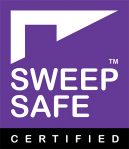Frequently Asked Questions
Chimney fires are an all too frequent occurrence in many homes every year. Regular maintenance and chimney sweeping are the best ways to avoid the hazards of a chimney fire, also the risks of poor performance and inadequate ventilation cannot be over emphasised as the risks of Carbon Monoxide poisoning are all too real.
How often should I sweep my chimney?
To help prevent a chimney fire occurring in your property, you should ensure your chimney is swept as often as recommended by the Solid Fuel Association.
Appliance Frequency:
• Smokeless Fuel Fire/Stove – Once per year
• Coal Fire – Twice per year
• Wood Burning Stove – Quarterly when in use
• Gas Appliance – Once per year if designed for chimney sweeping
• Oil Fired – Once per year
Does it make a mess?
The honest answer is not usually. We use the correct shielding/covering equipment and vacuum as advised by the APICS guild. So unless there is a major problem with the flue i.e. cracks in the frontage of the flue/chimney breast or a major bird’s nest, everything will be spotless. Saying that, it’s best to move ornaments and pictures from the immediate vicinity of the hearth.
I need a working space of approximately 3 feet deep and 5 feet wide immediately by the hearth.
I use carpet protectors, dust sheets and wear shoe protectors on every sweep.
Do I need to have a lined chimney swept?
Yes, contrary to belief, once you have had a liner installed on your appliance it is very important to sweep the chimney on a regular basis. Yearly minimal intervals are recommended, however it may be necessary to sweep the flue/chimney every three months when in use (depending on frequency of use and fuel used). Ask your chimney professional for advice, sweeping intervals can vary dramatically depending on the type of flue, type of appliance, if there is a boiler fitted, and the amount of chimney draw you have.
I have problems lighting my fire/smoke comes back into room/there are sooty marks on my wall?
These can be caused by a combination of issues, downdrafts, inadequate draw on flue, cracked chimney breast/masonry, or perhaps a bird’s nest or other flue blockage.
These (alongside the prevention of chimney fires) are some of the major reasons for having a Chimney Sweep visit, as there may be a high probability of dangerous Carbon Monoxide gas building up in the room where the faulty fire/appliance is sited.






